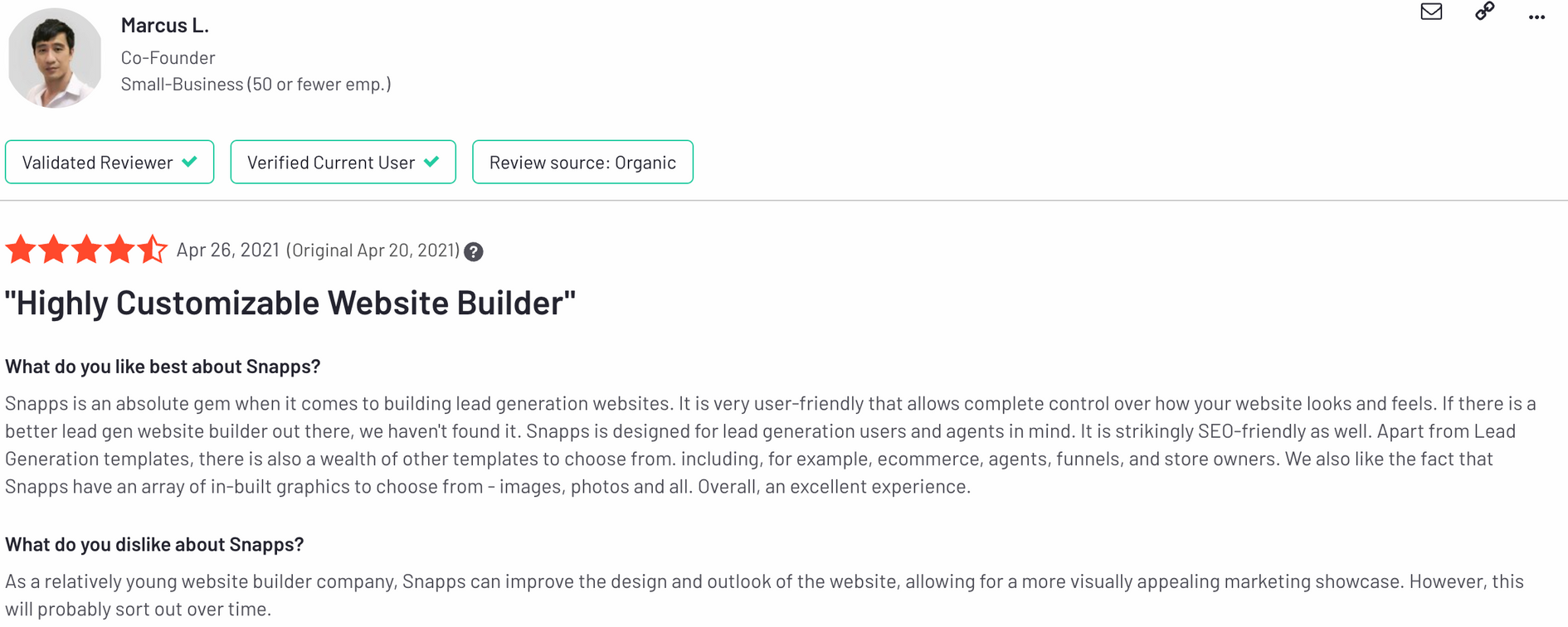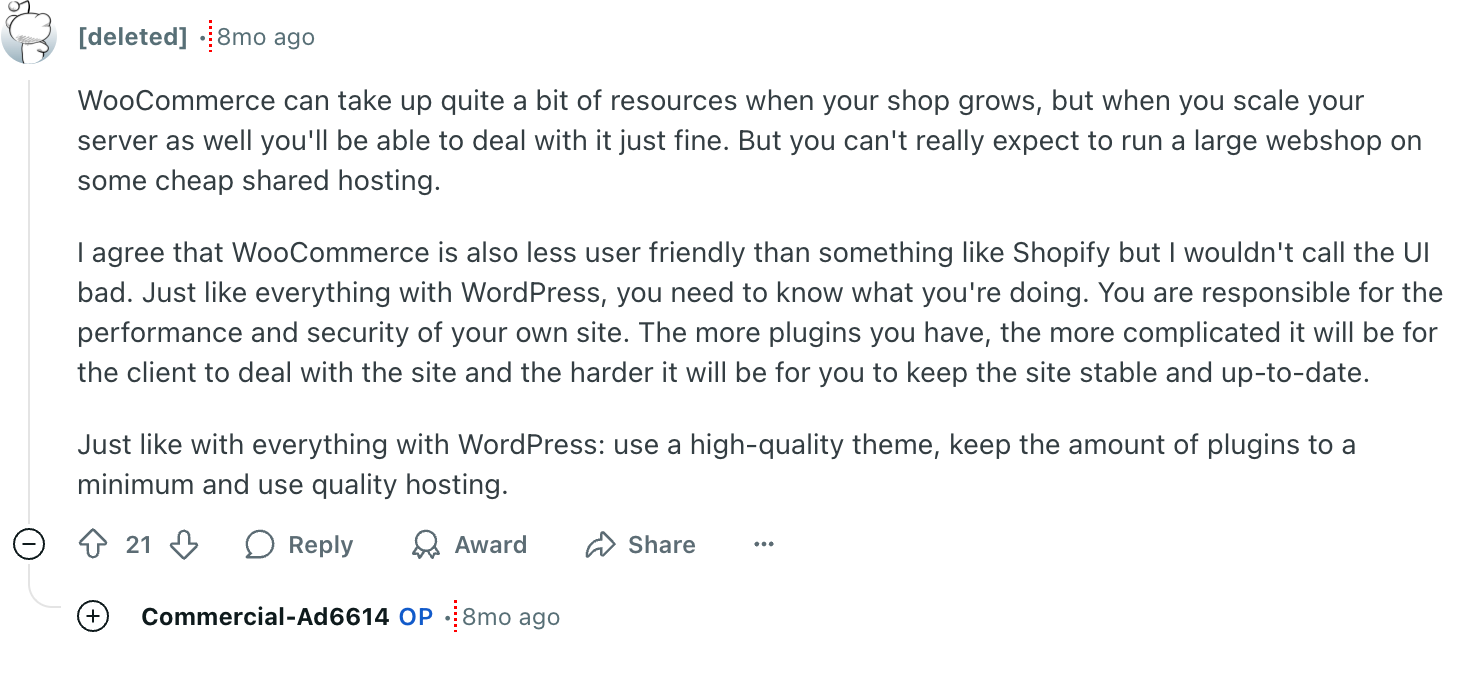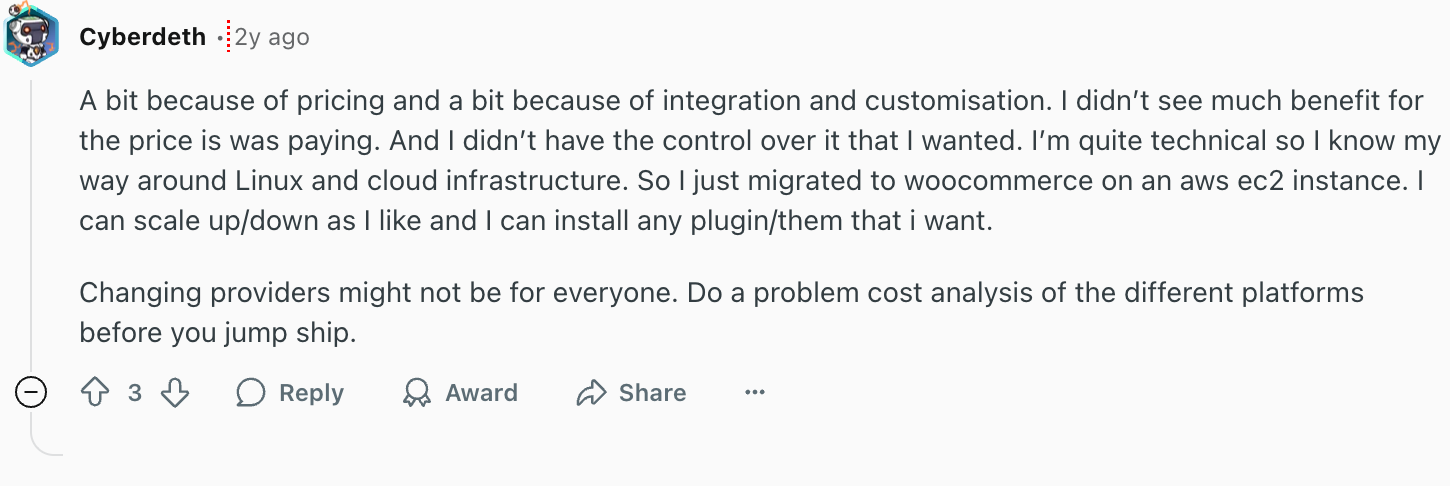Travis says other platforms are easier to use than Shopify for most e-commerce entrepreneurs. He suggests finding better builders that manage multiple small e-commerce sites on a tight budget, or for content-heavy businesses.
Snapps courses are now available
The best website builders for ecommerce are:
- Snapps.ai
- WordPress + WooCommerce
- Squarespace
- BigCommerce
- Wix
An ecommerce website must be user-friendly to focus on selling your products without dealing with technical issues. Website builders offer simplicity through pre-built templates and point-and-click functionality to save time. This ease of use benefits those with no coding skills in creating a professional site.


Besides ease of use, website builders enhance your online store website's performance. An ecommerce site experiences downtime, but a good builder optimizes templates, plugins, and visuals. Many Shopify store owners struggle getting customers because of bad design choices that make them appear untrustworthy to customers.

You might struggle to start an ecommerce site on Shopify, but many have better support to set up your site. These builders do not put limits on business needs and are easy to understand. They attract 67% more purchases than Shopify.
Let us examine the online store features of 5 website builders. This will help you choose which platform best suits your ecommerce needs. Here's a table of ecommerce builders, comparing user experience, performance, and support.
| Website Builder | User Experience | Performance and Reliability | Customer Support and Resources |
|---|---|---|---|
| Snapps.ai | 9 out of 10 | 8 out of 10 | 9 out of 10 |
| WordPress + WooCommerce | 8 out of 10 | 9 out of 10 | 7 out of 10 |
| Squarespace | 9 out of 10 | 8 out of 10 | 7 out of 10 |
| BigCommerce | 8 out of 10 | 9 out of 10 | 7 out of 10 |
| Wix | 7 out of 10 | 6 out of 10 | 8 out of 10 |
1. Snapps.ai
Snapps.ai is the best eCommerce web builder for creating and managing sites. The platform delivers fast, efficient, and user-friendly publishing. With over 200 templates, create a tailored ecommerce site for your stores.

Store owners choose Snapps.ai for its AI capabilities and user-friendly features. 78% prefer builders with drag-and-drop functionality for their ease of use. The platform gives digital agency owners, entrepreneurs, and marketers a no-code, reliable online store builder.
| Pricing Plan | Beta Pack | Starter Pack | Decade Pack | Agency Pro Pack |
|---|---|---|---|---|
| Site Limit | 1 site | 5 sites | 10 sites | 50 sites |
| SEO Tools | Basic | Advanced | Full Suite | Enterprise Level |
| AI Features | Limited | Standard | Advanced | Complete |
| Support Level | Standard | Priority | Premium | Dedicated Manager |
| Customization | Basic | Advanced | Full | White-label |
| Monthly Price | $8.08 | $66.25 | $132.50 | $495.83 |
Online Store Features:
- AI-Powered Content Creation: Transform your product descriptions and marketing content with intelligent automation.
- Advanced SEO Tools: This website builder includes technical SEO analysis.
- Visual Design Suite: Create product images and website elements using Snapps Graphics.
- Local Search Optimization: Track your store's visibility in searches with detailed ranking reports.
- Customization Widgets: Tools to make your online store visible, no tech expertise required.
Transitioning from Shopify to Snapps.ai comes with a migration wizard in 4 steps. The platform supports the transfer process, including template matching, data migration, and SEO. Its team makes sure your online store keeps its ranking and functionality during the switch.
| Feature | Snapps.ai | Shopify |
|---|---|---|
| Monthly Cost | Starts at $8.08 | Starts at $29 |
| Transaction Fees | None | 2% on basic plans |
| Built-in Apps | Comprehensive suite | Additional costs |
| Support | 24/7 with all plans | Limited on basic plan |
| Marketing Tools | Integrated AI tools | Requires app purchases |
Snapps.ai’s pros:
- AI-driven features for content and SEO
- Drag-and-drop interface
- A hundred template library
- Exceptional security measures
- Competitive pricing structure
Snapps.ai’s cons:
- Limited mobile editor functionality
- Requires time to learn advanced features
- Needs familiarity through template customization

Slide title
Write your caption hereButton
Slide title
Write your caption hereButton
Slide title
Write your caption hereButton
Slide title
Write your caption hereButton
2. WordPress + WooCommerce
WordPress is a popular ecommerce platform when combined with WooCommerce. WooCommerce transforms WordPress websites into flexible, customizable online stores. The plugin powers over 28% of all online stores, making it one of the most widely used ecommerce platforms.

This web builder is ideal for small businesses and entrepreneurs selling online. You control your store's design independently, but it is technical for starters. It depends heavily on high-quality themes, minimum plugins, and reliable hosting services.
| Pricing Plan | Cloud Startup | Cloud Professional | Cloud Enterprise |
|---|---|---|---|
| Site Limit | 300 sites | 300 sites | 300 sites |
| SEO Tools | Basic | Advanced | Enterprise |
| AI Features | Limited | Standard | Full Suite |
| Support Level | Community | Priority | Dedicated |
| Customization | Basic | Professional | Full Access |
| Monthly Price | $7.59/mo | $14.99/mo | $29.99/mo |
Online Store Features:
- Advanced Product Management: Transform your catalog with unlimited products and inventory tracking.
- Payment Integration Suite: Connect with over 100 payment gateways.
- Marketing Toolkit: Built-in SEO tools make this a good website wordpress option.
- Security Features: Good security with protected certification and regular updates.
- Analytics Dashboard: Reporting tools to track store performance and customer behavior.
WooCommerce has a four-step transition from Shopify. The platform provides migration tools and documentation for data transfer. Expert support is available for store owners at each migration stage.
| Feature | WooCommerce | Shopify |
|---|---|---|
| Monthly Cost | Starts at $7.59 | Starts at $29 |
| Transaction Fees | 0% | 2% on basic plans |
| Built-in Apps | Extensive free options | Most need payment |
| Support | Community + Documentation | 24/7 live support |
| Marketing Tools | Integrated WordPress SEO | Requires app purchases |
WooCommerce’s pros:
- Complete control over store customization
- No transaction fees
- Free plugin library
- WordPress integration
- Lower costs
WooCommerce’s cons:
- Not recommended for beginners
- Regular maintenance required
- Performance depends on hosting quality
- Store owners manage security and updates independently
- Some plugins conflict and need testing
3. Squarespace
Squarespace is for design-conscious businesses. Store owners select Squarespace for its world-class templates and ecommerce website design capabilities. The platform’s performance is reliable, but it needs more updates this year.

Like Snapps.ai, it has a point-and-click interface that 85% of users found to be easy to use. However, it is less flexible compared to other platforms and has a smaller app market.
| Pricing Plan | Basic Commerce | Advanced Commerce |
|---|---|---|
| Site Limit | Unlimited Sites | Unlimited Sites |
| SEO Tools | Basic SEO Suite | Advanced Analytics |
| AI Features | Product Descriptions | Full AI Content Suite |
| Support Level | 24/7 Standard | 24/7 Priority |
| Customization | Template-Based | Advanced Design Tools |
| Monthly Price | $40 (monthly) | $72 (monthly) |
Online Store Features:
- Digital Product Sales: Sell downloadable music, ebooks, and digital art through your site.
- Subscription Management: Manage revenue through monthly or biweekly subscription services.
- Custom Merchandising: Printful connects product lines and handles shipping.
- Service Booking Integration: Schedule appointments and client calendars through Acuity Scheduling.
- Connected Commerce Tools: Access integrations for accounting, label printing, and inventory tracking.
You can move your online store to Squarespace from their migration team. If you have a big Shopify store, you need manual adjustments.
| Feature | Squarespace | Shopify |
|---|---|---|
| Monthly Cost | $28 to 52 | $29-299 |
| Transaction Fees | None | 0.5 to 2% + gateway |
| Apps Needed | All-in-one | Extra purchases |
| Support | 24/7 all plans | Tiered support |
| Marketing Tools | Built-in suite | Need apps |
Squarespace’s pros:
- Appealing design templates
- Integrated marketing tools
- Mobile-first approach
- Reliable 24/7 support
Squarespace’s cons:
- Basic inventory management
- Limited advanced commerce features
- Does not customize templates well
- Sudden platform updates that cuts workflow
- Fewer third-party integrations

Simon Gorges’s review of Squarespace notes it's great customization features. It has 150 free templates that fit many industries. He likes the platform's "fluid engine" for easy website design suiting beginners and advanced users. It doesn’t offer a free plan but a 14-day trial subscription
4. BigCommerce
BigCommerce provides its services to 60,000 business people in 120 countries. Its nature is good for businesses, focusing on growth. The platform has good online store features, but consider the costs for this one.

Store owners consider BigCommerce for its enterprise features and scalability. The platform presents free trials, so businesses test its capabilities. The builder is a choice for technical customization supporting both beginners and developers.
| Pricing Plan | Standard | Plus | Pro |
|---|---|---|---|
| Site Limit | Unlimited | Unlimited | Unlimited |
| SEO Tools | Basic | Advanced | Enterprise |
| AI Features | Limited | Standard | Complete |
| Support Level | 24/7 Live | Priority 24/7 | Premium 24/7 |
| Customization | Basic | Advanced | Full |
| Monthly Price | $29 | $79 | $299 |
Online Store Features:
- Advanced Product Management: Create product variations with custom rules.
- Multi-Channel Integration: Connect your online store website to Amazon, eBay, and social platforms.
- Analytics Dashboard: Reporting tools tracking store performance, customer behavior, and sales metrics.
- Payment Processing: Integrate with over 65 payment gateways with built-in security.
Transitioning to BigCommerce involves a data transfer system. The migration team assist with templates, data, and customer information. They transfer data while maintaining search engine rankings.
| Feature | BigCommerce | Shopify |
|---|---|---|
| Monthly Cost | Starts at $29 | Starts at $29 |
| Transaction Fees | None | 2% on basic plans |
| Built-in Apps | Comprehensive suite | Extra costs |
| Support | 24/7 all plans | Limited on basic |
| Marketing Tools | Integrated features | Requires apps |
BigCommerce pros:
- Zero transaction fees
- Built-in B2B features
- Advanced SEO capabilities
- Multi-channel selling
- Unlimited products
- Automatic image optimization
BigCommerce cons:
- Revenue limits on each plan
- Steep learning curve for beginners
- Limited free themes
- Complex product upload process
- Automatic plan upgrades based on sales
- Higher pricing for advanced features

Kal Wiggins reviews BigCommerce as easy to set up and manage. It presents flexible customization options and strong integration capabilities. But its complexity may require a learning curve for serious online retailers.
5. Wix
Wix is another choice for online stores with an easy-to-use interface and template library. This platform powers over 5 million ecommerce website stores for digital entrepreneurs. Wix works well for blogs and basic business sites, but the pricing is not cost-effective.

Yet, some online stores choose Wix for its drag-and-drop editor and customization. 65% of non-technical users launch their online store within 2 weeks.
| Features | Light | Core | Business | Business Elite |
|---|---|---|---|---|
| Site Limit | 1 site | 3 sites | 5 sites | 10 sites |
| SEO Tools | Basic | Standard | Advanced | Enterprise |
| AI Features | - | Basic | Standard | Advanced |
| Support Level | Priority | Premium | Dedicated Manager | |
| Customization | Basic | Standard | Advanced | Full |
| Monthly Price | $17 | $29 | $36 | $159 |
Online Store Features:
- Advanced Design Templates: Over 500 templates optimized for online store free experience.
- Global Payments: Integration with over 50 gateways.
- Mobile Management: Complete store control through the Wix Owner app for business operations.
- Marketing Automation: Built-in email campaigns and abandoned cart recovery.
Owners must plan carefully to avoid the costs of switching from Shopify to Wix. Use a migration team and tools to transfer your products, customer data, and SEO elements.
| Feature | Wix | Shopify |
|---|---|---|
| Monthly Cost | Starts at $29 | Starts at $29 |
| Transaction Fees | None on business plans | 2% basic plan |
| Built-in Apps | Comprehensive suite | Additional costs |
| Support | 24/7 priority support | Limited on basic |
| Marketing Tools | Integrated solutions | Requires app purchases |
Wix's pros:
- Good visual editor
- 500+ industry-specific template library
- Built-in marketing tools
- No coding required
- Competitive pricing plans
Wix's cons:
- Limited scalability for high-volume stores
- Performance issues with bigger stores
- Higher costs for basic ecommerce apps
- Storage limitations on lower plans
Choose eCommerce Customization Features for a Site
- Focus on design flexibility. A website should have template options and layouts not needing coding.
- Adjusts in screen sizes and devices. A good website provides built-in mobile optimization tools and preview capabilities.
- Get multiple payment gateways. Your ecommerce website needs flexible options to serve global customers.
- Look for product display options. Choose features with many images, zoom capabilities, and variant options.
- Track stock levels and sync on sales channels. The system alerts you about low stock and manages warehouses.
- Customize checkout. Focus on one-page checkout options and abandoned cart recovery.
- Look for built-in SEO features. Optimize product pages and metadata so the online store ranks well in search results.
- Integrate analytics tools. Choose website builders for customization with tracking sales, customer behavior, and inventory movement.
- Secure transactions. Pick platforms with certificates that protect your website.
- Select features that grow with your business. The right platform manages high traffic while expanding product lines.
How to Generate Sales on Your eCommerce Website?
- Position your best-selling items. They should be on a homepage and category pages. This strategy generates sales on a small business while making popular products discoverable.
- Automate email marketing. Set up campaigns for cart abandonment and customer re-engagement.
- Display social proof. Present customer reviews, ratings, and user-generated content throughout your store.
- Create time-sensitive deals and flash sales. Get a website builder that supports countdown timers and promotional pricing features.
- Upsell products and bundles. Showcase complementary items during the checkout process to increase orders.
- Optimize mobile shopping experience. A smooth experience generates 70% of online store website traffic.
- Simplify checkout process. Reduce cart abandonment to support multiple payment methods and express checkout features.
- Integrate customer support. Provide live chat and help widgets to improve sales on your platform.
Snapps.ai: Best eCommerce Platform for Online Stores
Snapps.ai is the best website to start an online business. Unlike others, it combines AI-powered and design tools for personalized ecommerce websites. The platform has SEO tools, design, and templates for any business.
To generate more sales, the platform enhances product descriptions. Snapps also optimizes pricing strategies and marketing campaigns. To create a better shopping experience, combine advanced analytics and track customer behavior. Businesses achieve higher conversion rates than other online store website builders.
Snapps.ai has competitive pricing and no transaction fees for entrepreneurs and businesses. This platform provides balanced advanced functionality, customization options, and sales-generating capabilities.
Recent Articles
Our Support Heroes Are Here For You
Don’t waste time on tedious manual tasks. Let Automation do it for you. Simplify workflows, reduce errors, and save time for solving more important problems.



